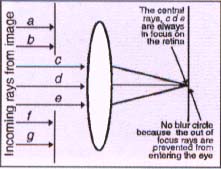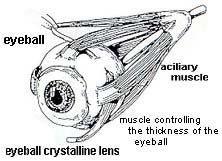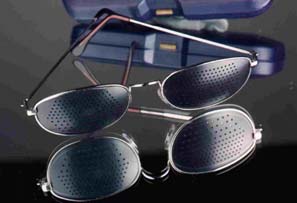NATURAL VISION IMPROVEMENT PINHOLE GLASSES
Discover how to relax your tired eyes and enjoy reading the healthy way
without prescription glasses.
The Downhill Slide.
When your eyes are placed behind normal prescription glasses you fall into a trap.
You no longer use the focusing muscles in your eyes to the full. This important "ciliary muscle" begins to weaken requiring visits to your eye doctor for stronger and stronger lenses. Reverse the downhill slide and help develop your eye muscles now.
Inexpensive - No Prescription Required.
Pinhole Glasses are inexpensive when compared to
prescription glasses. Now you can refresh your tired eye muscles and keep the eyes from staring - a
common cause for eye fatigue.
How They Work.
Pinholes provide an infinite depth of focus so that even when the eye is not correctly focused, objects will appear as if in focus. Importantly they eliminate scattering of light to the retina and hence improve vision.
The idea behind pin-hole glasses is not new. It was known centuries ago and was used before the advent of glass lenses. The reason they work is simple. "Light passing through a small hole (or holes) is restricted to rays coming straight from the viewed object; these rays do not need focusing to bring them to a point," according to Drs. Russell S. Worrall and Jacob Nevyas in The Eye Exorcisors published in The Health Robbers.
Just look through any pin-hole and you'll see what they mean. When you do this, blurred images become focused. This is because the amount of peripheral light rays (which are responsible for blurring) is reduced. With appropriately spaced multiple pin-holes, you'll get clear straight vision without the difficulty of concentrating on a single hole. Regular use of these special pinhole glasses helps exercise eye muscles and helps eyes relax at the end of a tiring day and thus has a beneficial effect. Particularly useful for those who spend a great deal of time looking at computer and/or TV screens, Pinhole Glasses help retrain your eye muscles, just as other forms of exercise retrain muscles elsewhere.
MORE ON PINHOLE GLASSES
Pinhole glasses (also known as stenopeic glasses) are not made of glass at all but of an opaque substance such as metal or plastic. The user looks through any of the many small holes in the material. These holes have the effect of reducing the width of the bundle of diverging rays (called a "pencil of light") coming from each point on the viewed object. Normally, the full opening of the pupil admits light. It is the improper bending of the outermost rays in that pencil of light which causes refractive errors such as myopia, hyperopia (farsightedness), presbyopia (diminished accommodative range with age) and astigmatism to be noticeable. Pinholes can bring about clearer vision in all these conditions.
By blocking these peripheral rays, and only letting into the eye those rays which pass through the center portion of the pupil, any refractive error in the lens or cornea is not noticed as much. Of course, in the case of myopia, let's not blame the lens or cornea. It is the abnormal lengthening of the eye which is the problem.
The pupil may be wide open, but only the central portion is receiving light. The improvement in visual acuity can be striking. Look at this Converging Lens and imagine it as the lens of the eye.
 All the light rays within the outermost yellow lines make up a pencil of light. Imagine that this bundle of light passes through one of the pinholes while rays outside this area are blocked. You will see that the eye does not need to deal with the rays that would need the most bending. It is said that Scheiner first described this effect in 1573. Those who are familiar with cameras will recognize that this is the same principle used to increase the depth of focus by decreasing the aperture. All the light rays within the outermost yellow lines make up a pencil of light. Imagine that this bundle of light passes through one of the pinholes while rays outside this area are blocked. You will see that the eye does not need to deal with the rays that would need the most bending. It is said that Scheiner first described this effect in 1573. Those who are familiar with cameras will recognize that this is the same principle used to increase the depth of focus by decreasing the aperture.
An easy way to demonstrate this is to make a fist and put it up to one eye while closing the other eye. Open the fist just enough to create a small hole to look through. If you have a refractive error, you should see clearer this way. This same improvement in the vision takes place when someone squints to see more clearly. The upper and lower eyelids cut off the rays that would normally enter the top and bottom of the pupil and the vision improves somewhat. Since there is no similar way to cut off rays entering the sides of the pupil, these rays still contribute to the blurred vision. Looking through pinhole glasses instead of squinting cuts off the peripheral rays from all sides. Since the holes themselves are so close to the eye, they are greatly out of focus and are not as disturbing as one might think.
After a period of getting used to them, the brain tends to ignore their presence. Also of interest is that the farther away the viewed object is, the less the pinholes are noticed. The honeycomb effect of the holes is easily noticeable when viewing a book held close to the eyes, because the eyes are focused just a short distance in front of the glasses. When looking at a distant TV, however, the holes are hardly visible at all since the eyes are focused much farther away. Also, because of the distance, you can view the entire TV screen through one hole, an obvious benefit.
One limitation of pinhole glasses is that blocking some of the light makes it more important than usual to have good lighting on the viewed object. When looking at television this is not a problem since the set makes its own light. When reading, a good lamp should be provided nearby. Another limitation is that peripheral vision is diminished, so they should not be used for driving or similar activities involving motion. As with any glasses, even sunglasses, they should not be used to stare at the sun, thinking that no harm can be done.
We do not claim that pinholes can replace prescription glasses in every situation. Just as it would be risky to wear ordinary glasses in situations where they could be broken and damage the eyes, there are situations where using pinholes instead of prescription glasses is not advisable. Use common sense and only wear the pinholes when the limited view does not pose a risk. No one who manufacturers or sells pinhole glasses can be held liable for misuse of these glasses since this is beyond their control.
While pinholes are not as cheap as off-the-rack reading glasses, they are considerable cheaper than individual prescription glasses. For example, a person who is a little nearsighted but only needs clear distant vision for occasional TV viewing would find pinholes a cheaper solution than prescription glasses. There is no need to continually throw away old pairs and buy new, stronger ones. Unless the pinholes break, they can be used an entire lifetime.
The native people of Alaska have long used this principle by wearing glasses with narrow slits to look through, thus blocking out much of the glare from the sunshine reflecting off the snow and ice. Anyone who remains in this environment for long periods during the summer without protection can suffer from snow blindness. This painful condition forces the person to discontinue the use of the eyes until healing can take place. This is nature's way of protecting the eyes from permanent damage.
Pinhole glasses are an excellent substitute for expensive bifocal glasses. They can provide good vision for any distance, both far and near.
There is a pincushion effect when looking through the edges of prescription glasses. That is, straight lines appear curved. This disturbing effect does not occur with pinholes.
When you lay prescription glasses down improperly, they can easily get scratched at the center of the lens, the very area you have to look through. Scratching pinholes has no effect on their performance.
Some people with cataracts have given testimonials that they see better with pinholes because the scattering of the light is diminished. A cataract is actually one or more opacities in the lens that do not allow the light to pass through properly but instead cause it to scatter. By cutting off the peripheral rays, pinholes could reduce some of this scattering and improve the vision. The only way to determine if an individual will benefit in this way is to try the glasses.
However, the most important use for pinholes is in an application that has until now been totally ignored, Myopia Prevention.
When a person's eye has become abnormally long due to excessive close work, the outermost rays come to a focus in front of the retina and cause the blurred vision.  Imagine for a moment the common situation where a child begins to develop myopia and can't see the blackboard clearly. The usual solution of giving the child minus lenses is disastrous. But suppose the child has a pair of pinholes and puts them on just to look at the blackboard. Imagine for a moment the common situation where a child begins to develop myopia and can't see the blackboard clearly. The usual solution of giving the child minus lenses is disastrous. But suppose the child has a pair of pinholes and puts them on just to look at the blackboard.
A large area of the blackboard can be seen through just one hole. The cost and the risk involved with minus lenses has been avoided entirely. Suppose the child also leaves them on when reading or looking at a computer screen. This could help greatly in preventing myopia since the accommodative effort is reduced. For those children whose natural farsightedness has diminished to around +0.5 diopters and are on the verge of moving into myopia, sitting down at the school desk and putting on the pinholes should be almost simultaneous events.
Many children might need nothing more than this to insure that they do not develop myopia. Schoolteachers should have several pairs on hand to lend to the students who have difficulty seeing the blackboard.
Can you imagine what the eye doctors and optical industry think about this inexpensive solution? The fact that you don't find pinholes in the optical stores and eye doctors don't recommend them should give you a hint. In fact, it is just this opposition that has resulted in government persecution of those who sold such glasses in the past. It is both enlightening and appalling to look at some of "these cases".
Glare protection for eyes dates back to prehistoric time. Some devices were made of bone, wood or hide, and had slits in them to protect the eyes from the glare of the sun, snow or sea water. These were tied round the head with strips of hide. Today a scientific version of the glare interceptor, called by the distributor Stenopeic (multiple-pinhole) spectacles in which 7 rows of pin-holes of specific size and spacings are placed in a plastic opaque material are available. These, after much experiment, were found to be valuable in certain cases of subnormal vision.
A few examples follow of the conditions in which they have been used successfully.
Complicated Cases
Recently a case was brought to my attention. It involved a young serviceman whose eyes had been injured by sulfur dioxide gas. Both corneas had been transplanted and his vision, uncorrectable with glasses, was 20/400 in each eye -which meant he was nearly blind.
After studying the case I recommended he be given stenopeic spectacles. With these, vision was improved to 20/70 and he could read 9-point type.
A 70 year old stockbroker had a mature cataract in his left eye and nuclear sclerosis with a small cupuliform opacity in his right crystalline lens. Stenopeic spectacles, by removing the disturbing veiling glare, gave him 20/30 distant vision and permitted 4-point type to be read without difficulty.
Other Complicated Cases
A recent case was most unusual. A 47-year old man had been disturbed for the past two years by seeing distant objects doubled through his only good eye. The other was amblyopic and markedly divergent. He consulted a qualified ophthalmologist who was puzzled and referred the patient to me. On refracting his seeing eye, I found he had excellent correctable vision, but even with correction he still noted a doubling of the hands on the large clock across the street and the red dots below the numbers on the dial. With stenopeic spectacles he was delighted to see everything sharp and with no doubling.
AMAZING EFFECT EXPERIENCED BY THE WEARERS
IN THE FIRST PLACE
You will see objects clearly through the pinholes drilled in the lenses. Even those who have near-sightedness, farisightedness, astigmatism, or amblyopia can see objects clearly through the small holes. In this case, the eyeball muscles of the wearer get normalized by themselves and the focus of the eyeball(the crystalline lens) is adjusted. The pinholes are small plain holes.
AFTER A SHORT PERIOD
If you look at things without the glasses after wearing them for about half an hour, you will be surprised that you can clearly recognize even very small letters. (However, you will be soon again unable to see distinctly).
AFTER A SHORT TIME
If you persist in wearing these glasses only a couple of hours a day while reading books or newspapers, or watching TV, and your eye problems are not hereditary, you will succeed in your sight-recovering exercise, and the eyeball muscles and cystalline lenses will be normalized.(You may not need glasses at all)
REMARKS OF AMERICAN DOCTORS ON THE INVENTION
- Dr. Janet Goodrich(a distinguished eye-sight-correcting specialist)
"People with both close and distant blur and astigmatism are able to use micohole sight correctors."
- Dr. David Michael(author of Visual Optics and Refraction)
"Microholes reduce aberrations and light scattering, isolate a favorable area of the damaged cornea and increase depth of focus."
- Dr. Norman Bies(author of Correction of Subnormal Vision)
"The longer depth of focus obtained through microholes is well established --- patients enjoy a substantial increase in reading distance."
|

 All the light rays within the outermost yellow lines make up a pencil of light. Imagine that this bundle of light passes through one of the pinholes while rays outside this area are blocked. You will see that the eye does not need to deal with the rays that would need the most bending. It is said that Scheiner first described this effect in 1573. Those who are familiar with cameras will recognize that this is the same principle used to increase the depth of focus by decreasing the aperture.
All the light rays within the outermost yellow lines make up a pencil of light. Imagine that this bundle of light passes through one of the pinholes while rays outside this area are blocked. You will see that the eye does not need to deal with the rays that would need the most bending. It is said that Scheiner first described this effect in 1573. Those who are familiar with cameras will recognize that this is the same principle used to increase the depth of focus by decreasing the aperture. Imagine for a moment the common situation where a child begins to develop myopia and can't see the blackboard clearly. The usual solution of giving the child minus lenses is disastrous. But suppose the child has a pair of pinholes and puts them on just to look at the blackboard.
Imagine for a moment the common situation where a child begins to develop myopia and can't see the blackboard clearly. The usual solution of giving the child minus lenses is disastrous. But suppose the child has a pair of pinholes and puts them on just to look at the blackboard.